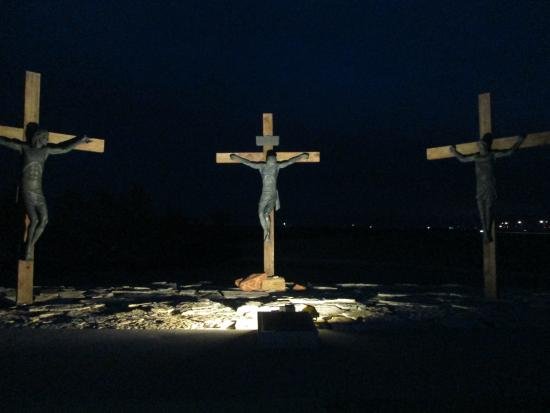– Darkness At Jesus Crucifixion: Irrefutable Proofs It Really Happened
Three distinctive events marked the moment Jesus died on the cross – the darkness that covered the earth, the earthquake and the dead rising back to life.
Naturally, many have attributed the darkness at Jesus crucifixion to an eclipse but as scholars tried to pinpoint the exact date of the crucifixion, placing it around AD 33, the possibility of an eclipse seem less and less plausible.
As a matter of fact, Brother Guy Consolmagno, director of the Vatican Observatory, in an email to Religion News Service, actually decried the possibility of the darkness being an eclipse. Even John Dvorak, author of “Mask of the Sun: The Science, History and Forgotten Lore of Eclipses.” corroborated this claim when he said, if there had been an eclipse, it was definitely not Solar Eclipse. He however suggested that it could have been a Lunar Eclipse.
Scholars who have zeroed in on April 3rd, A.D. 33, as the date of Jesus’ death, also presents a problem with the lunar eclipse theory. If there had been a total lunar eclipse that night, it likely would not have been visible from Jerusalem, where the Gospels record Jesus was crucified outside the city walls. Also the Gospel specifically mention that it was noon when the darkness at Jesus crucifixion fell upon the earth.
Rev. James Kurzynski of the Roman Catholic Diocese of La Crosse, Wis., expressed concern about the need for humanity to try to scientifically explain everything. where it could have been an act of God. He further said the question of the darkness being an eclipse is “a byproduct of living in a modernist culture that tries to explain everything with science.” He pressed further saying there must not necessarily be a natural explanation for everything in the bible.
However, he also tried to give it a simple explanation by suggesting it could have been a mass of cloud that covered the sun away.
Evangelist Anne Graham Lotz is of the opinion that it was God’s miraculous sign. She said the darkness “wasn’t just creation feeling sorry for the Creator, it wasn’t just a warning; it was a sign of God’s judgment.”
We know that the substitutionary atonement of Jesus for sinners made Him who knew no sin to become sin, thereby taking on the judgment they deserve. The book of Joel expounded on the day of the Lord (Judgement day) as a day of “darkness and gloominess” with the sun turning to darkness and the moon becoming blood.
Furthermore, during the 10 plagues God sent to Egypt to persuade Pharaoh to free Jewish slaves, one of the plagues was darkness covering the land. This also was a form of God’s judgement – a sign of warning for the future.
Thallus, an historian who wrote about a history of the eastern Mediterranean world since the Trojan War, documented his regional history in about AD 52. Although his original writings have been lost, he is specifically quoted by Julius Africanus, a renowned third century historian. Africanus stated that; ‘Thallus, in the third book of his histories, explains away the darkness as an eclipse of the sun—unreasonably as it seems to me.’ Apparently, Thallus while confirming the darkness and believably so due to the proximity of the year in which he documented history, he also made the error of ascribing the darkness to a naturalistic explanation.
SEE ALSO: #JesusInNairobi: Jesus Look-Alike Gets Crucifixion Threat
A Greek historian, Phlegon, who wrote an extensive chronology around AD 137, provides powerful confirmation of the Gospel accounts. He identifies the year and the exact time of day. In addition, he writes of an earthquake accompanying the darkness, which is specifically recorded in Matthew’s Gospel (Matthew 27:51), but also fallaciously ascribe the darkness to an eclipse.
His account is a very strong confirmation regardless of the eclipse exemption.
“In the fourth year of the 202nd Olympiad (i.e., AD 33) there was ‘the greatest eclipse of the sun’ and that ‘it became night in the sixth hour of the day [i.e., noon] so that stars even appeared in the heavens. There was a great earthquake in Bithynia, and many things were overturned in Nicaea.”
Africanus composed a five volume History of the World around AD 221. He was also a pagan convert to Christianity. His historical scholarship so impressed Roman Emperor Alexander Severus that Africanus was entrusted with the official responsibility of building the Emperor’s library at the Pantheon in Rome. Africanus writes:
“On the whole world there pressed a most fearful darkness; and the rocks were rent by an earthquake, and many places in Judea and other districts were thrown down. This darkness Thallus, in the third book of his History, calls, as appears to me without reason, an eclipse of the sun. For the Hebrews celebrate the passover on the 14th day according to the moon, and the passion of our Savior falls on the day before the passover; but an eclipse of the sun takes place only when the moon comes under the sun. And it cannot happen at any other time but in the interval between the first day of the new moon and the last of the old, that is, at their junction: how then should an eclipse be supposed to happen when the moon is almost diametrically opposite the sun? Let opinion pass however; let it carry the majority with it; and let this portent of the world be deemed an eclipse of the sun, like others a portent only to the eye. Phlegon records that, in the time of Tiberius Caesar, at full moon, there was a full eclipse of the sun from the sixth hour to the ninth—manifestly that one of which we speak. But what has an eclipse in common with an earthquake, the rending rocks, and the resurrection of the dead, and so great a perturbation throughout the universe? Surely no such event as this is recorded for a long period.”
SEE ALSO: Radio Host Says Eclipse Is A Sign Of Enemy’s Attempt To Obscure Light
Africanus rightly argues that a solar eclipse could not have occurred during the lunar cycle of the Passover. He also questions the link between an eclipse, an earthquake, and the miraculous events recorded in Matthew’s Gospel. Eclipses do not set off earthquakes and bodily resurrections. We also know that eclipses only last for several minutes, not three hours. For Africanus, naturalistic explanations for the darkness at Jesus crucifixion were grossly insufficient, as he showed by applying real science.
We must understand that the bible which contains the world of God also contains history, some of which are eyewitness account.
Rudolph Pesch, German New Testament scholar, gave a very compelling evidence when he dated the source for Mark’s Gospel to no later than AD 37 based on language, style, grammar, and personal references. This is a maximum of 4 years after the actual event! (Luke Gospel is at least 37 years after the crucifixion). This brings us to the conclusion that the Gospel accounts of the darkness at the crucifixion are extremely early, reliable, and based on eyewitnesses. Moreover, while we have attempted to bring varying evidences as proof, the synoptic Gospel remains the greatest evidence and proof that the 3-hour darkness, as well as the earthquake and resurrection of the dead are actual events!
SEE ALSO: Magnitude 3.7 Earthquake Hits Los Angeles Amidst Lockdown
References: Daniel Anderson [Creation.com], Andre Mitchell [Christiantoday.com], Emily McFarlan Miller [The Salt Lake Tribune]







